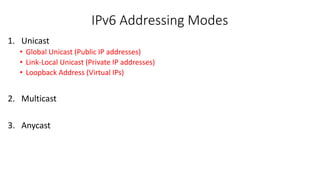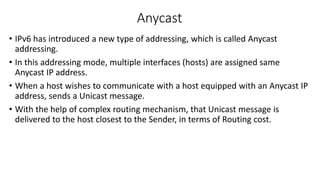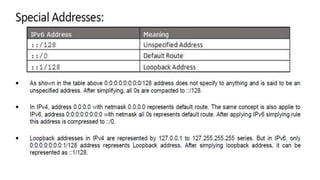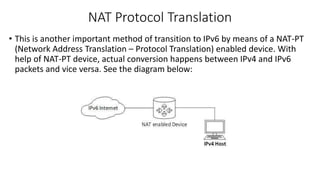A very good introduction to IPv6
- 1. Implementation of IPv6 Syed Arshad Network Security Engineer
- 2. What we are going to do • IPv6 Overview • IPv6 Features • IPv6 Addressing Modes • IPv6 Address Types • IPv6 Special Address • IPv6 Headers • IPv6 Communication • IPv6 Routing • IPv6 Implementation • IPv6 Summary
- 3. IPv4 Recall
- 4. IPv6 Overview • Internet Protocol version 6 (IPv6), is a new addressing protocol designed to incorporate whole sort of requirement of future internet known to us as Internet version 2. • IPv6 is a 128 bit address • It is represented as 32 hexadecimal numbers arranged in 8 quartets of 4 hexadecimal digit separated by a “ : ” • Ex: 2001:ABCD:25687:EFCD:ABCD:25687:EFCD:3458 • Case insensitive for A, B, C, D, E and F • IPv6 is currently a flat addressing scheme i.e, it is not divided into classes. Prefix Host
- 5. Why new IP version? • IPv4 has proven itself as a robust routable addressing protocol and has served human being for decades on its best-effort-delivery mechanism. • It was designed in early 80‟s and did not get any major change afterward. • At the time of its birth, Internet was limited only to a few Universities for their research and to Department of Defense. • IPv4 is 32 bits long which offers around 4,294,967,296 (232) addresses. This address space was considered more than enough that time.
- 6. Below are the few points for IPv6 birth • Internet has grown exponentially and the address space allowed by IPv4 is saturating. • IPv4 on its own does not provide any security feature which makes data vulnerable on Internet • Data prioritization in IPv4 is not up to date.
- 7. Wait
- 8. Where is IPv5 ? • Till date, Internet Protocol has been recognized has IPv4 only. • Version 0 to 3 were used while the protocol was itself under development and experimental process. • So, we can assume lots of background activities remain active before putting a protocol into production. • Similarly, protocol version 5 was used while experimenting with stream protocol for internet. • It is known to us as Internet Stream Protocol which used Internet Protocol number 5 to encapsulate its datagram. • Though it was never brought into public use, but it was already used.
- 9. IPv6 Features • Larger Address Space • Simplified Header • End-to-end Connectivity • Auto-configuration • Faster Forwarding/Routing • IPSec • No Broadcast • Anycast Support • Mobility • Enhanced Priority support • Smooth Transition • Extensibility
- 10. • Larger Address Space: • IP Version 6 is a 128 bit address • 2128 = 3.4 x1038 [Approx 340 Trillion Trillion Trillion IP addresses] • According to an estimate, 1564 addresses can be allocated to every square meter of this earth. • Simplified Header: • IPv6 header has been simplified by moving all unnecessary information and options (which are present in IPv4 header) to the end of the IPv6 header. • End-to-end Connectivity: • Every system now has unique IP address and can traverse through the internet without using NAT or other translating components • Auto-configuration: • IPv6 supports both stateful and stateless auto configuration mode of its host devices. This way absence of a DHCP server does not put halt on inter segment communication.
- 11. • Faster Forwarding/Routing: • Simplified header puts all unnecessary information at the end of the header. • All information in first part of the header are adequate for a Router to take routing decision thus making routing decision as quickly as looking at the mandatory header. • IPSec: • Initially it was decided for IPv6 to must have IPSec security, making it more secure than IPv4. This feature has now been made optional. • No Broadcast: • IPv6 does not have any Broadcast support anymore left with it. It uses multicast to communicate with multiple hosts.
- 12. IPv6 Addressing Modes 1. Unicast • Global Unicast (Public IP addresses) • Link-Local Unicast (Private IP addresses) • Loopback Address (Virtual IPs) 2. Multicast 3. Anycast
- 13. 1. Unicast • In unicast mode of addressing, an IPv6 interface (host) is uniquely identified in a network segment. • The IPv6 packet contains both source and destination IP addresses. A host interface is equipped with an IP address which is unique in that network segment. • A network switch or router when receives a unicast IP packet, destined to single host, sends out to one of its outgoing interface which connects to that particular host.
- 14. Unicast
- 15. • Global Unicast Address • This address type is equivalent to IPv4‟s public address. Global Unicast addresses in IPv6 are globally identifiable and uniquely addressable. • Global Routing Prefix: The most significant 48-bits are designated as Global Routing Prefix which is assigned to specific Autonomous System. Three most significant bits of Global Routing Prefix is always set to 001. • Link-Local Address • Auto-configured IPv6 address is known as Link-Local address. This address always starts with FE80. First 16 bits of Link-Local address is always set to 1111 1110 1000 0000 (FE80). Next 48-bits are set to 0 • Link-Local addresses are used for communication among IPv6 hosts on a link (broadcast segment) only. These addresses are not routable so a Router never forwards these addresses outside the link.
- 16. • Unique-Local Address • This type of IPv6 address which is though globally unique, but it should be used in local communication. This address has second half of Interface ID and first half is divided among Prefix, Local Bit, Global ID and Subnet ID. • Prefix is always set to 1111 110. L bit, which is set to 1 if the address is locally assigned. So far the meaning of L bit to 0 is not defined. Therefore, Unique Local IPv6 address always starts with „FD‟.
- 18. Multicast • The IPv6 multicast mode is same as that of IPv4. • The packet destined to multiple hosts is sent on a special multicast address. • All hosts interested in that multicast information, need to join that multicast group first. • All interfaces which have joined the group receive the multicast packet and process it, while other hosts not interested in multicast packets ignore the multicast information.
- 20. Anycast • IPv6 has introduced a new type of addressing, which is called Anycast addressing. • In this addressing mode, multiple interfaces (hosts) are assigned same Anycast IP address. • When a host wishes to communicate with a host equipped with an Anycast IP address, sends a Unicast message. • With the help of complex routing mechanism, that Unicast message is delivered to the host closest to the Sender, in terms of Routing cost.
- 21. Anycast Example
- 26. IPv6 Address Type • Before introducing IPv6 Address format, we shall look into Hexadecimal Number System. • Hexadecimal is positional number system which uses radix (base) of 16. • To represent the values in readable format, this system uses 0-9 symbols to represent values from zero to nine and A-F symbol to represent values from ten to fifteen. • Every digit in Hexadecimal can represent values from 0 to 15.
- 28. Address Structure • An IPv6 address is made of 128 bits divided into eight 16-bits blocks. Each block is then converted into 4-digit Hexadecimal numbers separated by colon symbol. • For example, the below is 128 bit IPv6 address represented in binary format and divided into eight 16-bits blocks: • 0010000000000001 0000000000000000 0011001000110100 1101111111100001 0000000001100011 0000000000000000 0000000000000000 1111111011111011 • Each block is then converted into Hexadecimal and separated by „:‟ symbol: 2001:0000:3238:DFE1:0063:0000:0000:FEFB
- 29. Cont.. • Even after converting into Hexadecimal format, IPv6 address remains long. IPv6 provides some rules to shorten the address. • These rules are: • Rule:1 Discard leading Zero(es): • In Block 5, 0063, the leading two 0s can be omitted, such as (5th block): 2001:0000:3238:DFE1:63:0000:0000:FEFB • Rule:2 If two of more blocks contains consecutive zeroes, omit them all and replace with double colon sign ::, such as (6th and 7th block): 2001:0000:3238:DFE1:63::FEFB Consecutive blocks of zeroes can be replaced only once by :: so if there are still blocks of zeroes in the address they can be shrink down to single zero, such as (2nd block): 2001:0:3238:DFE1:63::FEFB
- 31. IPv6 Header An Internet Protocol version 6 (IPv6) data packet comprises of two main parts: the header and the payload. The first 40 bytes/octets (40x8 = 320 bits) of an IPv6 packet comprise of the header 31
- 33. IPv6 – IPv4 to IPV6 • One problem in transition from IPv4 to IPv6 completely is that IPv6 is not backward compatible. • This results in a situation where either a site is on IPv6 or it is not. • Unlike an implementation of new technology where the newer one is backward compatible so the older system can still work with the newer without any additional changes. • To overcome this short-coming, there exist few technologies which can be used in slow and smooth transition from IPv4 to IPv6:
- 34. Dual Stack Routers It's a process of configuring IPv4 and IPv6 address on the same interface.
- 35. Tunneling • In a scenario where different IP versions exist on intermediate path or transit network, tunneling provides a better solution where user's data can pass through a non-supported IP version. • The above diagram depicts how two remote IPv4 networks can communicate via Tunnel, where the transit network was on IPv6. Vice versa is also possible where transit network is on IPv6 and remote sites which intends to communicate, are on IPv4.
- 36. NAT Protocol Translation • This is another important method of transition to IPv6 by means of a NAT-PT (Network Address Translation – Protocol Translation) enabled device. With help of NAT-PT device, actual conversion happens between IPv4 and IPv6 packets and vice versa. See the diagram below:
- 37. IPv6 Routing Protocols • RIPng (Routing Information Protocol Next Generation) • OSPFv3 • BGPv4 • EIGRPv6 • Other Protocols like • ICMPv6 • DHCPv6 • DNS
- 38. Configuring with IPv6 Router(config)#ipv6 unicast-routing Router(config-if)#ipv6 enable 38
- 39. Future of IPv6 • IPv6 enabled Internet version 2 will replace todays IPv4 enabled Internet. • When Internet was launched with IPv4, developed countries like US and Europe took the larger space of IPv4 for deployment of Internet in their respective countries keeping future need in mind. But Internet exploded everywhere reaching and connecting every country of the world increasing the requirement of IPv4 address space. • As a result, till this day US and Europe have many IPv4 address space left with them and countries like India and China are bound to address their IP space requirement by means of deployment of IPv6. • Most of the IPv6 deployment is being done outside US, Europe. India and China are moving forward to change their entire space to IPv6. • China has announced a five year deployment plan named China Next Generation Internet. After June 06, 2012 all major ISPs were shifted to IPv6 and rest of them are still moving. IPv6 provides ample of address space and is designed to expand today‟s Internet services. Feature-rich IPv6 enabled Internet version 2 may deliver more than expected.
- 40. Questions / Suggestions Please! 40
- 41. Thank you 41
- 42. Arsh Networks Syed Arshad Cisco (R&S, Security and Wireless) | Checkpoint | UTMs | Linux |Microsoft | VMware E-Mail : [email protected] Blog : http://arshnetworks.blogspot.com/ Skype : arshnetworks 42
Editor's Notes
- #37: A host with IPv4 address sends a request to IPv6 enabled Server on Internet which does not understand IPv4 address. In this scenario, NAT-PT device can help them communicate. When IPv4 host sends a request packet to IPv6 Server, NAT-PT device/router, strips down the IPv4 packet, removes IPv4 header and adds IPv6 header and passes it through the Internet. When a response from IPv6 Server comes for IPv4 host, the router does vice versa.










![• Larger Address Space:
• IP Version 6 is a 128 bit address
• 2128 = 3.4 x1038 [Approx 340 Trillion Trillion Trillion IP addresses]
• According to an estimate, 1564 addresses can be allocated to every square meter of this
earth.
• Simplified Header:
• IPv6 header has been simplified by moving all unnecessary information and options
(which are present in IPv4 header) to the end of the IPv6 header.
• End-to-end Connectivity:
• Every system now has unique IP address and can traverse through the internet without
using NAT or other translating components
• Auto-configuration:
• IPv6 supports both stateful and stateless auto configuration mode of its host devices.
This way absence of a DHCP server does not put halt on inter segment communication.](https://image.slidesharecdn.com/implementationofipv6-141001104455-phpapp01/85/A-very-good-introduction-to-IPv6-10-320.jpg)































